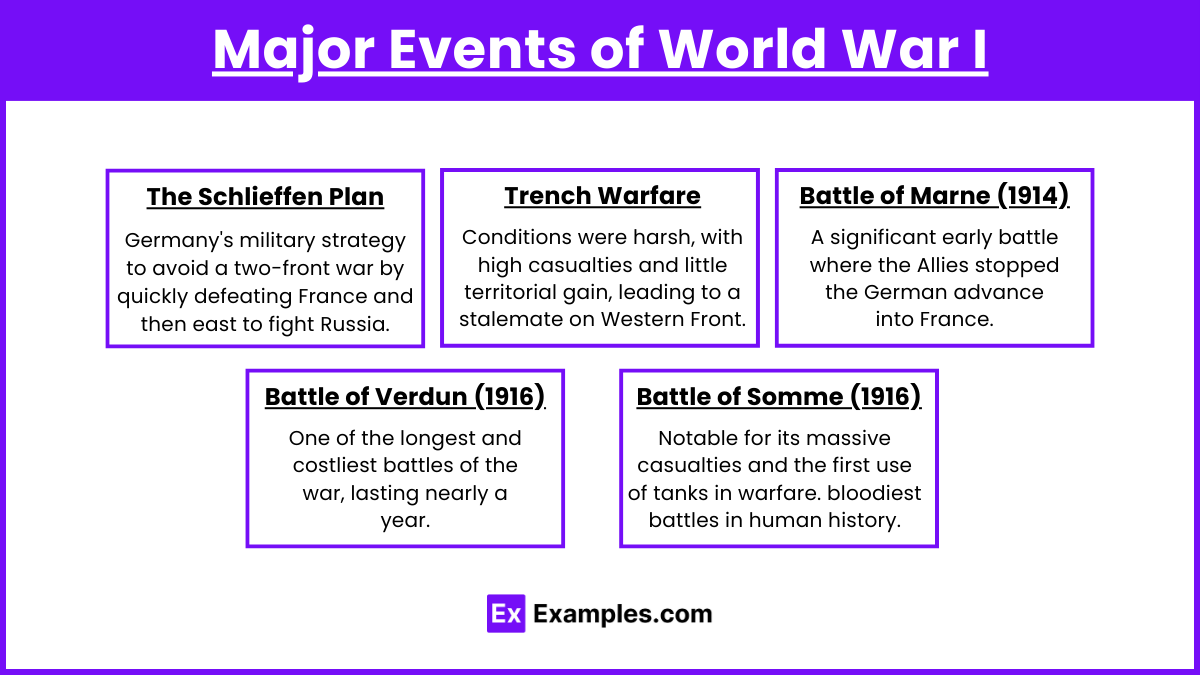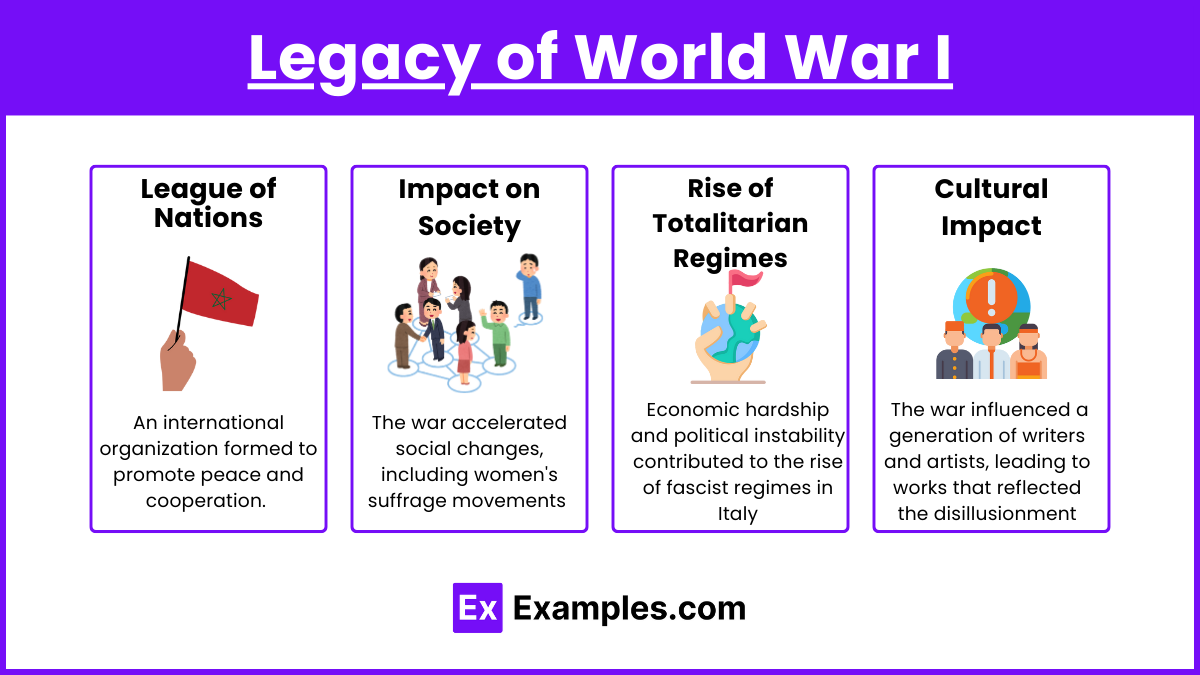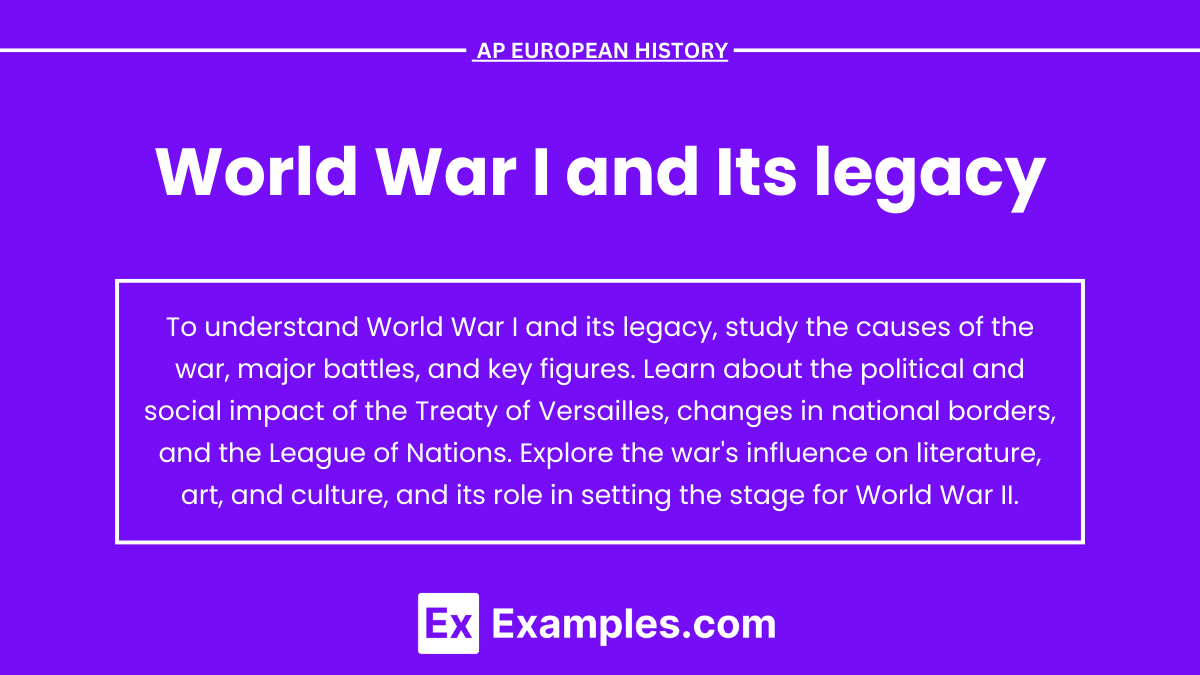World War I, also known as the Great War, was a pivotal conflict from 1914 to 1918 that reshaped the world. It involved major global powers and resulted in significant political, social, and economic changes. Understanding the causes, events, and aftermath of World War I is crucial for mastering AP European History. The war’s legacy includes the Treaty of Versailles, the fall of empires, and the rise of totalitarian regimes, all of which influenced the course of the 20th century.
Learning Objectives
In studying “World War I and Its Legacy” for the AP European History exam, focus on understanding the root causes, including militarism, alliances, imperialism, and nationalism. Examine key events such as the assassination of Archduke Franz Ferdinand, major battles, and the US entry into the war. Analyze the Treaty of Versailles, political and social changes, and the war’s long-term impact on Europe, including the rise of totalitarian regimes and cultural shifts. Grasp the profound consequences and how they set the stage for World War II.
Causes of World War I

- Militarism : Belief in building up strong armed forces to prepare for war. European nations expanded their armies and navies, leading to an arms race and heightened tensions.
- Alliances : Agreements between nations to provide mutual support in case of conflict. Two major alliances formed: 1. Triple Alliance: Germany, Austria-Hungary, Italy. 2. Triple Entente: France, Russia, Britain
- Imperialism : Policy of extending a nation’s authority by territorial acquisition or by establishing economic and political dominance over other nations. Competition for colonies and resources created conflict among European powers.
- Nationalism : Strong sense of pride and loyalty to one’s nation or ethnic group. Nationalist sentiments fueled tensions, particularly in the Balkans where Slavic nationalism clashed with Austro-Hungarian control.
- Assassination of Archduke Franz Ferdinand : On June 28, 1914, Archduke Franz Ferdinand of Austria-Hungary was assassinated by Gavrilo Princip, a Serbian nationalist. This event triggered a chain reaction of alliances being called into action, leading to the outbreak of war.
Major Events of World War I

- The Schlieffen Plan
- Germany’s military strategy to avoid a two-front war by quickly defeating France and then turning east to fight Russia.
- The plan failed, leading to a prolonged and grueling conflict on both fronts.
- Trench Warfare
- Characterized by long, static front lines and extensive trench systems.
- Conditions were harsh, with high casualties and little territorial gain, leading to a stalemate on the Western Front.
- Battle of the Marne (1914)
- A significant early battle where the Allies stopped the German advance into France.
- Marked the end of mobile warfare on the Western Front and the beginning of trench warfare.
- Battle of Verdun (1916)
- One of the longest and costliest battles of the war, lasting nearly a year.
- French and German forces suffered heavy casualties, with little strategic advantage gained by either side.
- Battle of the Somme (1916)
- Notable for its massive casualties and the first use of tanks in warfare.
- British and French forces attempted to break through German lines, resulting in one of the bloodiest battles in human history.
Outcomes of World War I
World War I, which ended in 1918, had profound and far-reaching outcomes that reshaped the political, social, and economic landscapes of Europe and the world.
1. Treaty of Versailles (1919)
- Details: The Treaty of Versailles was the peace settlement that ended the war between Germany and the Allied Powers. The treaty imposed heavy reparations on Germany, limited its military, and forced it to cede territory to neighboring countries.
- Impact: The harsh terms led to significant economic hardship and political instability in Germany, fostering resentment that contributed to the rise of Adolf Hitler and the outbreak of World War II.
2. Political Changes
- Fall of Empires: The Austro-Hungarian, Ottoman, German, and Russian empires collapsed, leading to the redrawing of national boundaries in Europe and the Middle East.
- New Nations: Several new countries were created from the former empires, including Poland, Czechoslovakia, Yugoslavia, and Finland. These new nations often faced ethnic tensions and political instability.
3. Social and Economic Impact
- Loss of Life: Approximately 10 million soldiers and 7 million civilians died during the war, leading to a profound demographic impact and a generation marked by loss.
- Economic Strain: The war caused massive economic disruption, including destroyed infrastructure, high national debts, inflation, and unemployment. Many European economies struggled to recover, leading to widespread social unrest.
4. League of Nations
- Details: The League of Nations was established as an international organization aimed at maintaining peace and preventing future conflicts. It was one of President Woodrow Wilson’s Fourteen Points.
- Impact: While the League had some successes, it ultimately failed to prevent aggression by totalitarian regimes in the 1930s, partly due to the lack of enforcement power and the absence of major powers like the United States.
5. Technological and Military Changes
- Innovations: The war saw significant advancements in military technology, including the use of tanks, airplanes, machine guns, and chemical weapons. These innovations changed the nature of warfare and had lasting impacts on military strategy.
- Legacy: The horrors of trench warfare and the massive casualties led to a reevaluation of military tactics and a greater emphasis on avoiding large-scale, prolonged conflicts.
Legacy of World War I

1. League of Nations
- Details: An international organization formed to promote peace and cooperation. It ultimately failed to prevent future conflicts, partly due to the absence of the US and the inability to enforce its resolutions.
2. Impact on Society
- Social Changes: The war accelerated social changes, including women’s suffrage movements and changes in social class structures.
- Technological Advances: Innovations in warfare technology, such as tanks, airplanes, and chemical weapons, had lasting impacts on future conflicts.
3. Rise of Totalitarian Regimes
- Details: Economic hardship and political instability contributed to the rise of fascist regimes in Italy and Germany, setting the stage for World War II.
4. Cultural Impact
- Literature and Art: The war influenced a generation of writers and artists, leading to works that reflected the disillusionment and trauma of the conflict. Notable examples include the “Lost Generation” writers and Dadaist artists.
World War I was a defining moment in world history. Its causes were rooted in deep-seated political, social, and economic factors. The war itself was marked by unprecedented destruction and loss of life. The outcomes and legacy of World War I shaped the 20th century, leading to significant political changes, social transformations, and the eventual rise of World War II. Understanding the complexities of World War I is crucial for grasping the broader historical context of modern Europe and the world.
Examples
Example 1: Poland’s Independence
Before World War I, Poland had been partitioned and divided among Russia, Germany, and Austria-Hungary for over a century. The war and the subsequent Treaty of Versailles in 1919 restored Poland as an independent nation, significantly altering the political landscape of Europe.
Example 2: The League of Nations and the Mandate System
The League of Nations established the Mandate System to administer former territories of the German and Ottoman Empires. For instance, Britain gained mandates over Palestine and Iraq, while France controlled Syria and Lebanon, reshaping the Middle Eastern political boundaries.
Example 3: Germany’s Hyperinflation Crisis
In the early 1920s, Germany faced severe economic turmoil due to the reparations imposed by the Treaty of Versailles. This led to hyperinflation, where the German Mark became virtually worthless, creating widespread poverty and economic instability in the country.
Example 4 : Women in the Workforce
During the war, many women took on roles traditionally held by men, such as working in factories and serving as nurses. This shift contributed to the women’s suffrage movement, resulting in women gaining the right to vote in many countries, including the United States (1920) and the United Kingdom (1918).
Example 5 : Introduction of Tanks
Tanks were first used in combat during World War I by the British Army at the Battle of the Somme in 1916. These armored vehicles changed the dynamics of ground warfare, providing new strategies for breaking through enemy lines and leading to their widespread use in future conflicts.
Multiple Choice Questions
Question 1: What was a significant impact of the Treaty of Versailles on Germany?
a) It allowed Germany to keep all its territories.
b) It imposed heavy reparations and territorial losses on Germany.
c) It strengthened Germany’s military power.
d) It resulted in an alliance between Germany and the United States.
Answer: b) It imposed heavy reparations and territorial losses on Germany.
Explanation: The Treaty of Versailles, signed in 1919, was a peace treaty that ended World War I. It imposed severe penalties on Germany, including significant territorial losses and heavy reparations payments. The treaty aimed to limit Germany’s military power and prevent future aggression. These harsh terms contributed to economic difficulties and political instability in Germany, which eventually led to the rise of Adolf Hitler and the outbreak of World War II.
Question 2: Which organization was established after World War I to promote international cooperation and prevent future conflicts?
a) The United Nations
b) The North Atlantic Treaty Organization (NATO)
c) The League of Nations
d) The European Union
Answer: c) The League of Nations
Explanation: The League of Nations was established in 1920 as part of the Treaty of Versailles. Its primary goal was to promote international cooperation, disarmament, and the peaceful resolution of disputes. Although it aimed to prevent future conflicts, the League of Nations ultimately failed to prevent the outbreak of World War II due to its lack of enforcement power and the absence of key nations like the United States.
Question 3: How did World War I contribute to the rise of totalitarian regimes in Europe?
a) It led to economic prosperity and political stability.
b) It created widespread economic hardship and political instability.
c) It resulted in strong democratic institutions across Europe.
d) It eliminated nationalist sentiments in Europe.
Answer: b) It created widespread economic hardship and political instability.
Explanation: The aftermath of World War I left many European countries in economic turmoil and political disarray. The harsh terms of the Treaty of Versailles, particularly for Germany, led to economic hardships, unemployment, and hyperinflation. The social and economic instability created fertile ground for totalitarian ideologies. Leaders like Adolf Hitler in Germany and Benito Mussolini in Italy capitalized on the discontent and unrest, promising to restore national pride and stability, which ultimately led to the rise of totalitarian regimes in Europe.


